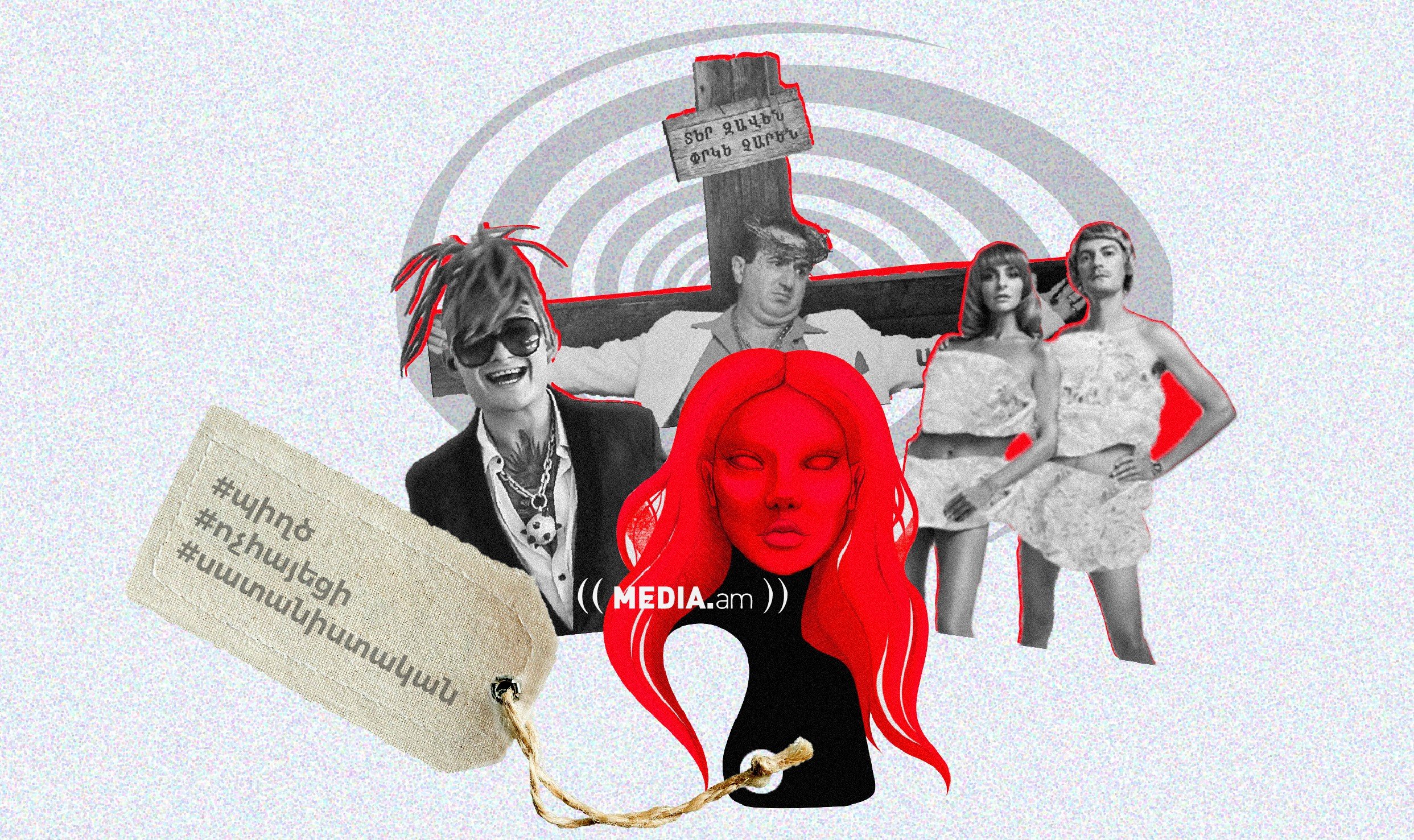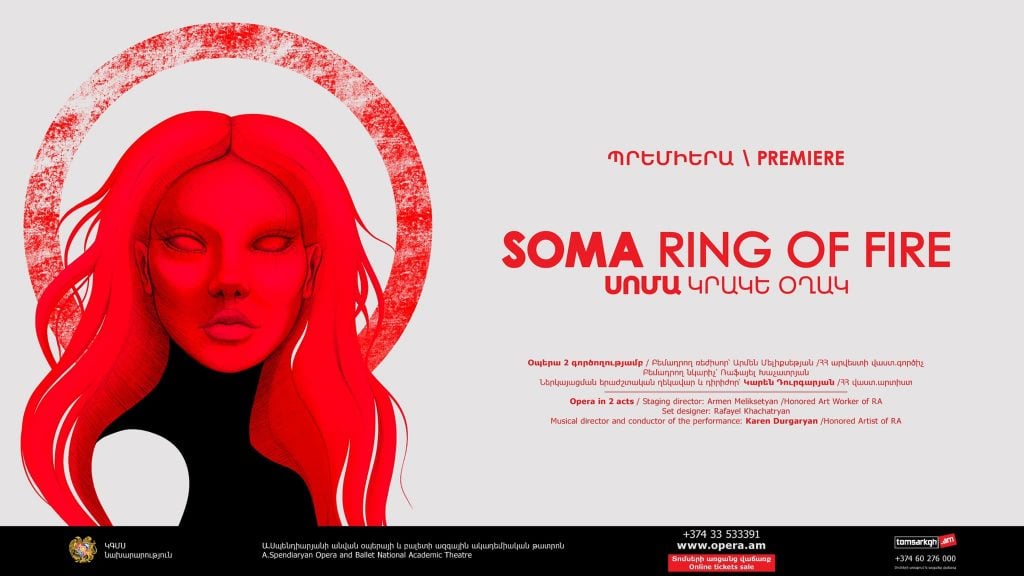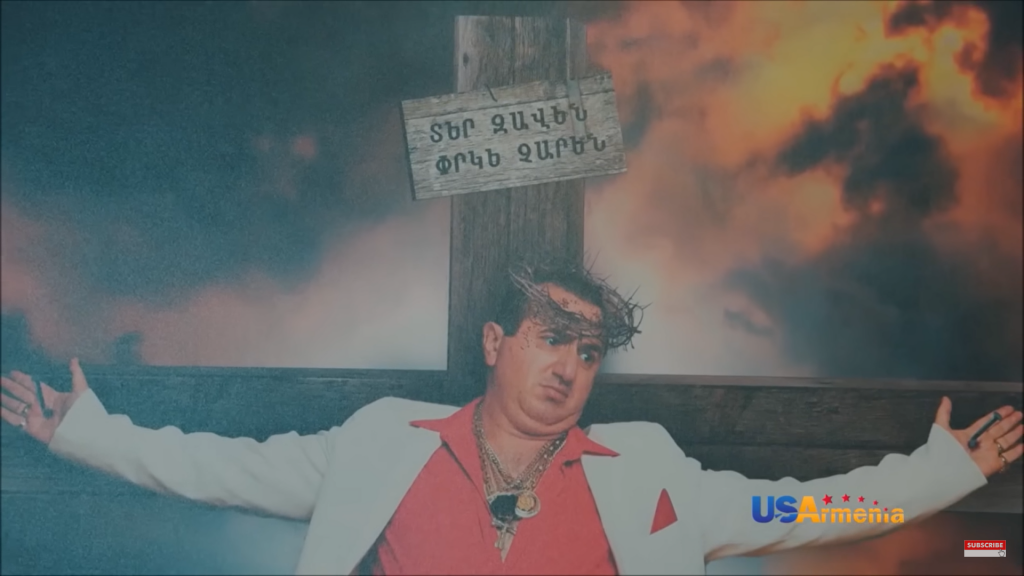
Content that provokes disputes and discussions regularly appears in the Armenian media field, which is generally quickly labeled as diabolical, vile, nation-destructive, etc. It’s hard to say what goals the people pushing these narratives are pursuing, but it’s clear that they’re playing with people’s minds by activating a basic trigger like fear: fear of loss (be it national identity, dignity, or even the territory of the country), regression, destruction, etc.
It is very easy to anger a society that is experiencing post-traumatic stress, and works of art have long been the easiest source of that anger. There was no shortage of such cases in 2022: from an opera to a concert of a Russian rapper, Gor Vardanyan’s TV series, and a poster for the performance.
In this article, we will discuss not the cultural values of the presented examples, but the noise generated around them and their origins.
Soma, Ring of Fire

The poster of the opera “Soma, Ring of Fire” by Indigo Branding Agency
Soma was one of the longest cases of mudslinging of the year. On the eve of the 125th anniversary of Yeghishe Charents, the Opera and Ballet Theater of Armenia presented Avet Terteryan’s opera “Soma, Ring of Fire” to the audience, which the theater described as the author’s most beautiful work.
The first announcement about the premiere was published on February 28. All feedback was ecstatic, with not a single negative opinion or complaint. The second post was on March 11, after which the campaign against the opera began. The criticism was based on Charents’ work “Soma”, Soma herself as a negative religious figure and the illustration of the red woman on the cover.
Presuming from the timestamps of the comments, the first to express his displeasure was Armen Hareyan, a semi-deacon of the Armenian Apostolic Church serving in the Eastern Diocese of the USA, who has more than 20,000 followers. “[…] Have you read Soma’s lyrics? Is that it? The Opera is betraying Christianity just like that all of a sudden, or is Christianity no longer a faith for either it or any of you[…]?
According to Hareyan, showing this performance and giving it a “Satan-worshiping like” means worshiping soma, as a result of which God will call everyone to retribution. He also emphasized that it is because of similar “evils” that “we partially lose our protection”.
Minutes after the deacon’s comment, the downpour of shaming and condemning comments and the disputes that arose from them began. The authors and supporters were called “Satanists spreading filth under the guise of art, devils propagating Satanism in a Christian country, etc.”

On March 15, Armen Hareyan posted a picture on his Facebook page with the caption “demon in the opera” on the opera’s advertising poster. Here, he criticized not only the authors of the play and the structure that staged it but also Yeghishe Charents, urging the public to “know those whom you called great.”
Considering Soma as an Indian goddess, Hareyan considers the content of the poem to be opposed to “Our Father,” demonic and idolatrous.
In his post, Armen Hareyan says things that there is no possibility to verify or any reason to believe. For example, the fact that he was told that “most of the participants do not want to participate in this demonic worship.” As for the manipulative expression that “we lose wars because of such things that deny God,” there’s no need for commentary. That post has 700 likes, 265 comments, and 429 shares.
There was a lot of attention around the demonized opera, which is why the Opera Theater’s post on March 24 was attacked by Hareyan’s sympathizers. They repeated the same narratives that the demi-deacon dictated. And already under the first video of the performance, some comments appeared that the day of the premiere, April 14, was not chosen by chance (that day was Maundy Thursday).
Actually, Soma has nothing to do with demons and is better known as Chandra. In Hinduism, she is the goddess of fertility, of the moon, people, animals, and vegetation. The deity is also a miraculous tincture made from the soma plant, which granted immortality to Indian gods.
Залечь на дно в Ереване (Lay Low in Yerevan)

The first poster for the performance ”Залечь на дно в Ереване” (Lay Low in Yerevan)
The theatrical performance Lay Low in Yerevan with the group of stars from the Russian TNT TV channel was supposed to be a piece with sharp humor and an intriguing plot as promised by the organizers, but alas… Armenian Internet users immediately noticed the actors’ naked bodies covered with lavash.
The comments were harsh and unequivocal: the poster disrespects Armenian values, the Armenian nation, and culture because lavash is sacred and registered in UNESCO’s intangible cultural heritage protection list.
Let’s put aside the idea of whether bread is holy or not. The thing is when people who are angry in such conversations turn to the responsible structures and always receive “dispersive” answers, as the National Academic Theater named after Sundukyan did. The answer was something like this, “The show hadn’t been confirmed yet, and we hadn’t even seen the poster…” The poster was completely replaced with foil.

The second poster for the performance ”Залечь на дно в Ереване” (Lay Low in Yerevan)
There was a similarly silent approach concerning the concert of the death metal group Vader, when the Puppet Theater (where the concert was supposed to take place), swallowing manipulations and misinformation stating that a satanic ritual was going to take place in Yerevan, chose to cancel the show instead of conducting explanatory work. It should be noted that the concert took place, however, at Poligraf Club.
Compensation: Corruption 2

A scene from the TV series “Compensation: Corruption 2”
It seemed that Gor Vardanyan’s TV series, in addition to becoming part of memes, received serious criticism when this noise was raised for the first time. But here the problem was only related to mocking the Armenian Apostolic Church and religion.
Armen Hareyan, who promptly updates his internet blogs, expressed his displeasure with the episode presented in the TV series “Compensation: Corruption 2” shown on “Yerkir Media,” where a rich man hung a picture of himself crucified on the wall of his house. Apart from that, other characters present in the scene also made mocking comments. He once again connected such phenomena with the defeat of the Armenian nation and mentioned that as a result of mocking God, the unborn children of the members of the cast and team of the series may have incurable diseases or be born sick, etc.
Hareyan’s video on Facebook gathered more than 30 thousand views and the same number of angry people. The rapidly spreading sensational footage forced the Television and Radio Commission (TRC) to issue an official statement. According to the commission, that scene of the series degrades and discredits universal values, the Armenian Apostolic Church, as well as other religious organizations registered and operating in Armenia.
So, before that, there were no problems in the projects of Gor Vardanyan, a sportsman, actor, and adviser to the former mayor of Yerevan. We turn a blind eye to the episodes containing violence, sexism, racism, homophobia, and other vicious portrayals in local TV series and programs. But as soon as the issue reaches religious topics in a secular country, the problem is finally noticed and condemned.
The last paragraph of the TRC statement is encouraging, where it is stated that the series may violate norms that have a possible negative impact on the health, mental and physical development, and upbringing of minors, which contribute to the spread of the morals, mannerisms, and speech patterns of the criminal world in society, criminal characters and of romanticizing the lifestyle. The commission will refer to it if necessary.
Morgenshtern’s Concert

Morgenshtern’s Yerevan concert poster
Let’s end the satanic party with a theme that heralds the beginning of this year: The concert of the famous Russian rapper named Morgenshtern was supposed to take place in Yerevan. Here the situation was a bit more multi-layered: Churchmen and newsmen worked by passing on each other’s words.
The first of the reactions were again from semi-deacon Armen Hareyan, who, noticing the tattoo with the inscription “666” on the rapper’s forehead (which according to him is the sign of the Antichrist), said that he was mocking Christianity and the Church of Christ.
Hareyan was followed by Ter Yeznik. He condemned the rapper for promoting immorality, drug addiction, and anti-Christianity among teenagers and young people. In another sentence, he called the artist a Satanist and claimed that, according to a study by the Fact Check Platform, was false. This was regarding the fact that Morgenstern mocked and insulted Armenians during the 2020 Artsakh war. In our searches, we have not found any mocking or other references to Armenians.
And in the media field, the topic of the rapper was actively covered by the Armenian “Sputnik,” which reported that “there were almost no free tickets left” on the website tomsarkgh.am. Meanwhile, in a conversation with the Armenian Times, the representative of the organizer of the concert “Prime Production” denied the information about the large sale of tickets.
It seemed that the bursts of passion would calm down after the concert, but then mushroom sites that which fip.am has already written about started to get to work, writing that Morgenshtern announced that the show would be canceled, “if you don’t want to see me, then I don’t care about you.” In fact, the rapper did not make such a statement.
Summary
Is it worth giving more weight to the words of different Internet users and commenting on extremist and baseless discussions? It turns out that the answer is yes because whether it is a doctor, a lawyer, a blogger, or a priest online, they have tens of thousands of followers and can attract even wider circles with “precise manipulations.” Unfortunately, all this is working out successfully for them, and the public, being unknowingly used, becomes the one who advances these individuals’ personal interests and goals.
Let’s recall the already mentioned “satanic concert” of the group Vader, the performance of “HuZANG and ZANG” that reached the point of physical violence, the Conservatory’s “satanic party,” or the movie “Mel.” All these cases became a tool in the hands of opposition-government, Christian-atheist, and groups opposing anything artsy-fartsy.
Religious (cult) associations and new religious movements work according to a clear ideology: what is outside their movement is dangerous, and destructive, and salvation is only within them.
The Republic of Armenia is a secular country and operates according to criminal and administrative codes. And religious dogmas do not have the force of law. But in the flood of these guiding and propagating forces, such a closed association exists, where everything “other” is dirty, satanic, and non-Armenian.
Christian Ginosyan
The views expressed in the column are those of the author's and do not necessarily reflect the views of Media.am.


Add new comment
Comments by Media.am readers become public after moderation. We urge our readers not to leave anonymous comments. It’s always nice to know with whom one is speaking.
We do not publish comments that contain profanities, non-normative lexicon, personal attacks or threats. We do not publish comments that spread hate.